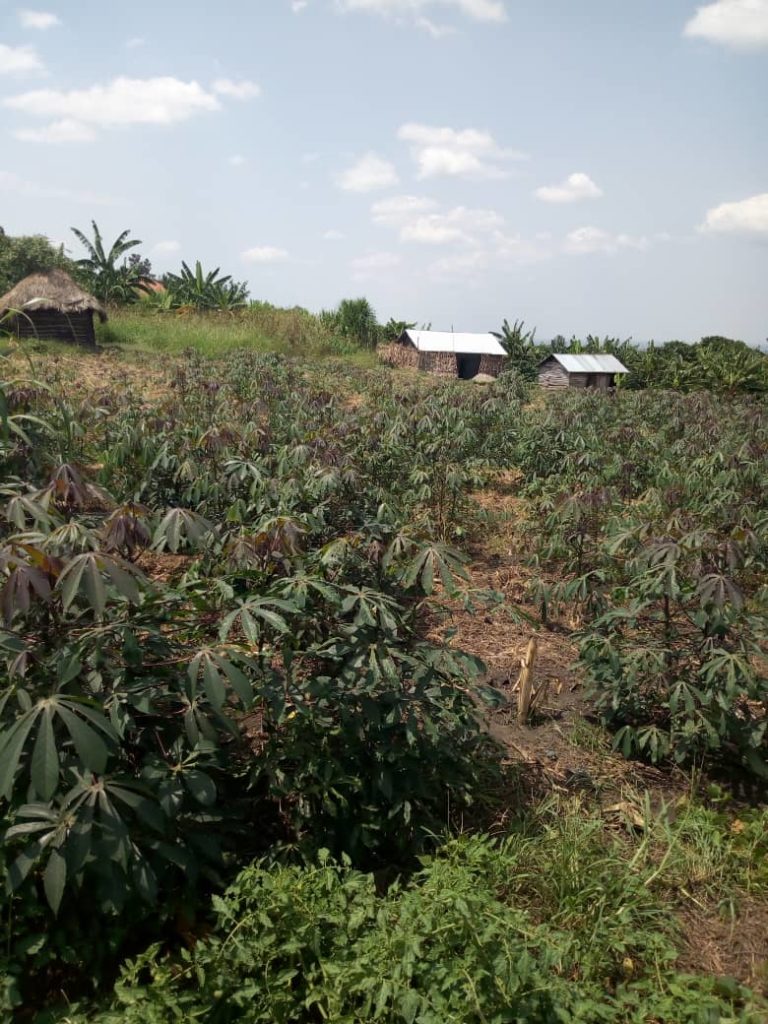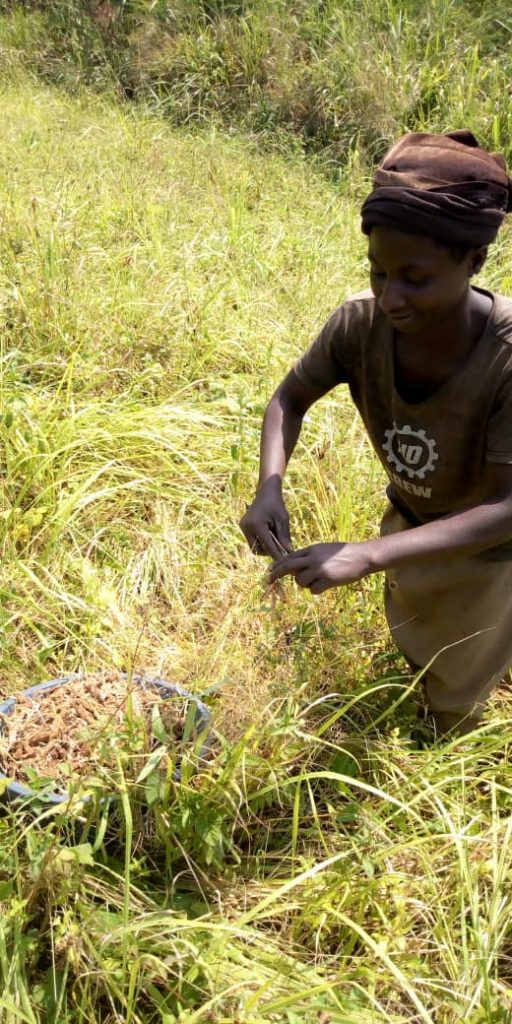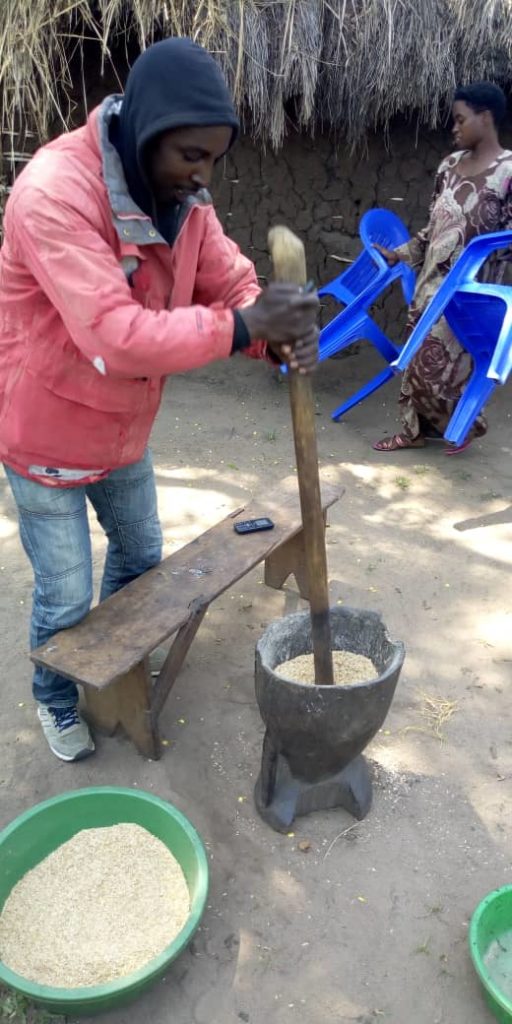![INDIGENOUS COMMUNITIES WHERE THE AFRICAN INSTITUTE FOR CULTURE AND ECOLOGY [AFRICE] WORKS INDIGENOUS COMMUNITIES WHERE THE AFRICAN INSTITUTE FOR CULTURE AND ECOLOGY [AFRICE] WORKS](https://africeug.org/wp-content/uploads/2019/01/A-woman-in-Kikarara-Rukungiri-spreads-maize-to-dry-before-storage-768x1024.jpg)
INDIGENOUS COMMUNITIES WHERE THE AFRICAN INSTITUTE FOR CULTURE AND ECOLOGY [AFRICE] WORKS
The culture of the people who live in the areas where AFRICE works:
The project area is located near L. Edward and Queen Elizabeth National Park, at
Rwenshama Fish Landing Site and Kikarara Village in the District of Rukungiri. This area is part of a bigger geographical area known as the Virunga Landscape, which is part of the Albertine Graben. The area is occupied by Banyabutumbi, Bahooro,Bakingwe, Bakonjo and Banyaruguru indigenous communities. There are, however,migrant populations in the area who include: Bakiga, Batooro, Banyoro, Banyankore,among others. Therefore, there is a mixture of indigenous and migrant populations whose culture, nature and spirituality are intertwined and in turn affect their culture,food and livelihood activities.

Inter cropping- A woman in Kikarara village weeding 
family memebers spread millet and maize to dry . In the background is a granary under construction. Rwenshama village near Lake Edward. 
An amaranths plant which co-grows with other crops. It is a medicine as well as food. 
Agroecology-Several crops varieties intercropped to avert risk of climate change. Kikarara Village. 
A young man prepares harvested finger millet grain for storage in Kikarara village, Rukungiri District. 
A woman in Rwenshama harvests a staple food crop (finger millet) 
A woman in Kikarara-Rukungiri spreads maize to dry before storage_1 
A woman harvests Pumpkins – Kikarara Village , Rukungiri District 
A man pounds dry cassava in a traditional motar_ Rwenshama Village near lake Edward, Rukungiri
AFRICE’s area of interest is to accompany indigenous communities and strengthen their capacities to revive their traditions and practices in land governance, food and culture. It therefore, works with indigenous communities whose traditions and
cultures are being undermined and eroded by the cultures of migrant populations.
This has in turn caused food insecurity, biodiversity loss and ecosystems
degeneration. It is true that the livelihood activities of the indigenous communities
respected the relationship between human beings and nature and almost all
practices ensured preservation of biodiversity and harmonious living.
A brief navigation of the culture of the indigenous communities illuminates the
connectedness between land, food, spirituality and nature. Although the indigenous
communities in the area are politically and administratively organised according to
districts [Local Governments], their social organisation and cohesion is based on the
‘tribe’ and ‘clan’ systems. The people, especially the Banyabutumbi have strong
customs and belief systems. Most of the cultural practices are associated with
conservation of the lake, forests, big trees, wild life and food. There are traditional
elders who act as spiritual mediums between the people, and the ancestors. These
elders are custodians of earth laws and customs. The people know that it involves
sacrificing animals and chicken, seed, bark-cloth, traditional alcohol, millet flour to
keep the ecosystems healthy and productive. Sacrifices are also made whenever
there are problems such as diseases, poor harvests, lack of rain, and misfortunes.
The custodians who perform the rituals receive fish, meat or animals and this
practice provides the custodians with a livelihood.
The other cultural practice relates to trees and childbirth. When a male child is born,
a ficus tree (omutooma) is planted and for females a banana tree (food crop) is
planted. The ficus tree’s bark is used to make bark-cloth for sale thus highlighting
the connection between males and economic activities. The connection between
women and food security is also embedded in the cultural practice of planting food
crops for female children. Therefore, these trees are revered because they
represented connection between the living (child) and the dead (ancestors). This
practice strengthens the link between child birth and environmental protection.
However, this practice has been distorted by modern development as children are
born in hospitals, not homes (ancestral grounds) and therefore few trees are planted,
moreover alien and invasive trees; an explanation of the disconnection between the
people and nature.
Trees have cultural value of promoting social cohesion. It is a taboo to cut trees with
spiritual value. Such trees would only be cut after custodians of earth laws had
performed certain rituals.
In addition, there are cultural beliefs and practices associated with death and these
promote food security, social cohesion and ensured discipline, hard work and
conformity to cultural norms. For example, every family grew enough food crops for
their homes, burial and other community festivals. Families that disrespected clan
norms were not accepted and so were their food contributions. Such families were
looked at as outcasts. They would be accepted back after they conformed to the
cultural practices of that clan. However, traditional spiritual practices are being
eroded by modern religion especially Christianity which portrays spirits (emandwa)
and African traditional religious practices as being satanic.
Sacred Natural Sites and Territories (SNST):
SNST play a very important role in the culture of the people in the region. SNSs are
describes as “critical places within ecosystems, such as forests, mountains, rivers
and sources of water, which are of ecological, cultural and spiritual importance, and
exist as a network embedded within a territory”. Territory encompasses all living and
non-living entities, including ancestral spirits, on land, water and air, and vertical
areas deep into the earth such as the sub soil, minerals and waters, and up into the
sky to the constellations.
Amongst these people, Sacred Natural Sites and Territories are recognized as
sources of traditional knowledge and laws that govern society, maintain community
cohesion and the health and wellbeing of humans as well as other species. Sacred
Natural Sites are a source of spiritual connection, health and wellbeing of humans,
they are believed to protect humans from enemies and evil and also sustain
ecosystems and life. These serve as places of worship, have spiritual values,
cleansing of families whose relatives befell catastrophe, protection of fishermen from
the dangers on the lake, increasing of fish and crop yields, and protection against
diseases and sources of herbal medicines.
The indigenous communities used to live in harmony with other beings. This
harmonious relationship was possible because of their connectedness with each
other. Rituals that were performed at sacred sites strengthened this relationship.
Whenever there was conflict between human and other beings, rituals would be
performed to improve the relationship, which conserved and preserved all species.
Sacred Natural Sites where Banyabutumbi used to conduct rituals but have been
denied access because they are in the Queen Elizabeth National Park are:
Omwihango, Omukiti Kyendeberanamu and Omusimba.
The Lake Edward ecosystem has a wealth of other beings/species. The relationship
between humans and other beings (animals) was a harmonious one. Their
relationship was not antagonistic and ancestors guided humans on how to relate with
other beings. It is known that the animals reciprocate the behaviour exhibit by
humans towards them – if humans became hostile to animals, the animals would
know it too well and would in turn become hostile. So, it was important for humans to
treat animals as their fellow beings in order to live with them in harmony.
It is also true that some custodians would directly speak to the animals and the latter
would understand and respond to the communication. They understood that the
animals also had physical and behavioural characteristics like those of humans.
They were social and moved in groups; and ate some of the foods which humans
also enjoyed like obukanja. The animals enjoyed the company of humans and this
lasted as long as humans did not harm them.
The Seed:
In these communities, indigenous seeds have an important role to play in the social
and bio culture of the communities. The communities know and value the connection
between the seed, biodiversity and their spirituality. Increased farm yield and food
sustainability depended on how the community, led by elders, performed seed rituals
before the planting season. Each house hold contributed a variety of seeds and
presented them to an elder (traditional spiritual leader) who would in turn, together
with animal sacrifice and chicken, take them to a sacred natural site for the
consumption of ancestors. This ritual was performed also when there was a pending
calamity or sickness in the community. The seed of crops and animal is therefore a
spiritual medium between the people and their ancestors and a determinant of their
wellbeing.
Different seed rituals ranging from, cementing individual friendships, inter family and
clan cohesion and land blessing were common in these indigenous peoples. Thus,
disappearance of these seed varieties leading to disappearance of values and
significances of these rituals and ceremonies has resulted into reducing farm yields,
food insecurity and death of community cohesion and solidarity.
Indigenous seeds are highly nutritious, medicinal, tasty when compared with hybrid
varieties. Planting of seeds is not only for food. Several diseases treated by these
seeds are known by these people, either through eating, direct application to the
body or performance of a ceremony with the seed. Also, indigenous seeds are more
resilient to unpredictable and changing weather patterns.
Under the traditional beliefs and practices, some seed varieties were taken in high
regard and their preservation was a collective responsibility within the household
setting. There was a strong traditional system within the community setting in which
knowledge on the roles and values of each seed variety would be passed on to
young generations. These traditional systems for sharing knowledge at both
household and clan levels have since weakened.
Traditionally, communities and households had various local seed varieties which
were grown, preserved and stored in a given season. It was from this unlimited
access that households choose which ones to plant in the next season. Thus,
traditionally communities and households had rights over which type of seed they
wished to grow, preserve, store or sell at a given time. Communities and households
grew enough food for its population and whenever famine struck, there were local
seeds that were grown to buffer the meagre supplies in hard times, including
pumpkins and cassava –known for being drought resistant.
Among the Banyabutumbi, all community members had to first do community
gardening to the Chief Custodian of the biggest sacred Natural sites called Mbogo.
Communities mobilised themselves and cultivated the gardens of Mbogo who in turn
blessed them to go and cultivate their gardens and get bumper harvests. At
household level, which consisted of senior and young families, the daughters and
sons in law first cultivated for the senior family. For example, it was a taboo for a
daughter –in-law to open up her land before helping a mother-in-law to cultivate her
garden. Indeed, it was believed that a stubborn daughter-in-law would experience
crop failure. Once the younger family cultivated for a senior family, the senior family
also blessed the younger family and also provided the high-quality seed for planting.
In this manner of reciprocity, the households and communities had adequate food for
every member of the community.
Indeed, Mbogo the chief custodian blessed fishermen to have bumper catches of fish
at different times. Whenever they harvested, the fishermen brought to the custodian
who would also share with other community members he considered more
vulnerable. It is also known that, during the times of Mbogo, community members
would ask for game meat and he would advise them to wait till the following day and
they would find unconscious game animals near their homes, which they would then
skin and eat.
For each food activity, certain ritual(s) would be conducted to honour the ancestors
and elders who were believed to be the main providers of the food. The planting
season had its own rituals to enhance productivity, provide rains and control
pesticides and predators. At harvesting time, other rituals were conducted to thank
the elders and ancestors for the good harvests. As mentioned earlier even at times
of poor harvests and crop failure, still certain rituals would be conducted in
consultation with the custodians to improve the situation in the next season.
The ability of elders to read and interpret the cosmology enabled them to explain
appropriate seasons for planting specific crops, thus avoiding different climate
change impacts and vagaries of weather.
The Farming Systems of The People in The Lake Edward Ecosystem:
Edward Ecosystem is occupied by Banyabutumbi, Bakingwe, Bahooro and other
indigenous communities who practice subsistence mixed farming systems. The
Banyabutumbi are both small scale farmers and fishers. The Farming community
lives South East of the L. Edward in a village called Kikarara in Rukungiri District and
currently use both out of farm and on farm in puts, i.e. animal and plant manure,
inorganic fertilisers and chemical pesticides; Manual labour is provided by family
members. The fisher folk live around the lake, mainly on Rwenshama Fish landing
site, where, until about 40 years ago, they used traditional fishing methods
characterized by hand made materials. They never used fishnets which were
introduced by government and other people who are non-indigenous.
In the farming communities, the hand- hoe is used as the predominant technology for
cultivation. About 40 years ago, majority of these households produced sufficient
amounts of food to feed their families, a phenomenon that is now changing which is
attributed to the loss of traditional cultures.
The main farming characteristics are:
Communities largely depend on hybrid seed varieties provided by Government;
Traditional seed varieties are fast disappearing pesticides has resulted in loss of
soil fertility and resistance to pests and diseases, forcing communities to
surrender to hybrid seeds now provided by government.
Crop rotation is fast disappearing because of reduced land sizes and mixed
cropping is also reducing, only left with older men and women who still hold this
knowledge.
Agroforestry has completely disappeared.
It is important to note that the purpose of AFRICE’s intervention in the area was to
build the confidence of the people for them to revive and strengthen their traditional
cultural governance systems on food and natural heritage. These systems as
explained in the first section of this narrative were so strong about 40 years ago but
have since been suppressed by modern education systems and new religious